Effect of Redispersible Latex Powder and Fly Ash on Properties of Mortar
Abstract
:1. Introduction
2. Materials and Methods
2.1. Test Materials
2.1.1. Cement
2.1.2. Sand
2.1.3. Fly Ash
2.1.4. Redispersible Latex Powder
2.2. Mix Ratio Design
2.3. Test Methods
2.3.1. Setting Time Test
2.3.2. Flexural Strength Test
2.3.3. Compressive Strength Test
2.3.4. Compressive Fracture Resistance Than
2.3.5. Drying Shrinkage Test
3. Results
3.1. Setting Time Test
3.2. Flexural Strength Test
3.3. Compressive Strength Test
3.4. Compressive Fracture Resistance Than
3.5. Drying Shrinkage Test
4. Conclusions and Prospects
4.1. Conclusions
4.2. Prospects
Author Contributions
Funding
Institutional Review Board Statement
Informed Consent Statement
Data Availability Statement
Conflicts of Interest
References
- Travincas, R.; Bellei, P.; Torres, I.; Flores-Colen, I.; Matias, G.; Silveira, D. The Use of Fibreglass Mesh in the Experimental Characterisation of Applied Coating Mortars. Coatings 2022, 12, 1091. [Google Scholar] [CrossRef]
- Bonilla, A.; Villaquirán-Caicedo, M.A.; de Gutiérrez, R.M. Novel Alkali-Activated Materials with Photocatalytic and Bactericidal Properties Based on Ceramic Tile Waste. Coatings 2021, 12, 35. [Google Scholar] [CrossRef]
- Chetty, K.; Watson, M.; Raine, T.; McGurgan, T.; Ladislaus, P.; Chen, J.; Zhang, S.; Lin, L.; Jiang, G. Enhancing Concrete and Mortar Properties and Durability Using Pristine Graphene Particles. Coatings 2022, 12, 1703. [Google Scholar] [CrossRef]
- Shi, T.; Liu, Y.; Zhao, X.; Wang, J.; Zhao, Z.; Corr, D.J.; Shah, S.P. Study on mechanical properties of the interfacial transition zone in carbon nanofiber-reinforced cement mortar based on the PeakForce tapping mode of atomic force microscope. J. Build. Eng. 2022, 61, 105248. [Google Scholar] [CrossRef]
- Wang, Y.; Lu, H.; Xiao, R.; Hu, W.; Huang, B. Experimental Study on the Stability and Distribution of Air Voids in Fresh Fly Ash Concrete. Materials 2022, 15, 8332. [Google Scholar] [CrossRef]
- Zhang, L.; Ding, D.; Zhao, J.; Zhou, G.; Wang, Z. Mixture Design and Mechanical Properties of Recycled Mortar and Fully Recycled Aggregate Concrete Incorporated with Fly Ash. Materials 2022, 15, 8143. [Google Scholar] [CrossRef]
- Bilir, T.; Gencel, O.; Topcu, I.B. Properties of mortars with fly ash as fine aggregate. Constr. Build. Mater. 2015, 93, 782–789. [Google Scholar] [CrossRef]
- Hsu, S.; Chi, M.; Huang, R. Effect of fineness and replacement ratio of ground fly ash on properties of blended cement mortar. Constr. Build. Mater. 2018, 176, 250–258. [Google Scholar] [CrossRef]
- Phoo-Ngernkham, T.; Sata, V.; Hanjitsuwan, S.; Ridtirud, C.; Hatanaka, S.; Chindaprasirt, P. High calcium fly ash geopolymer mortar containing Portland cement for use as repair material. Constr. Build. Mater. 2015, 98, 482–488. [Google Scholar] [CrossRef]
- Kosior-Kazberuk, M. Surface Scaling Resistance of Concrete with Fly Ash From Co-Combustion of Coal and Biomass. Procedia Eng. 2013, 57, 605–613. [Google Scholar] [CrossRef]
- Liang, S.; He, C.; Gong, X.; Feng, D.; Liu, L. Experimental study on shear strength and leaching toxicity of soil-cement mixed with pretreatment waste incineration fly ash. Bull. Silic. 2020, 39, 507–512. [Google Scholar] [CrossRef]
- Zhang, W.; Huang, Y. Three-dimensional numerical investigation of mixed-mode debonding of FRP-concrete interface using a cohesive zone model. Constr. Build. Mater. 2022, 350, 128818. [Google Scholar] [CrossRef]
- Han, F. Experimental Study on the Effect of Redispersible Latex Powder on the Performance of Cement Stabilized Macada. Master’s Thesis, Hefei University of Technology, Hefei, China, 2021. [Google Scholar] [CrossRef]
- Moskalova, K.; Aniskin, A.; Kozina, G.; Soldo, B. The Rheometric Analysis of the Polymer Modifier’s Properties in the Environment of Hydrated Cement. Materials 2021, 14, 1064. [Google Scholar] [CrossRef]
- Tao, Y.; Mohan, M.K.; Rahul, A.; Yuan, Y.; De Schutter, G.; Van Tittelboom, K. Stiffening controllable concrete modified with redispersible polymer powder for twin-pipe printing. Cem. Concr. Res. 2022, 161, 106953. [Google Scholar] [CrossRef]
- Bin Mobarak, M.; Hossain, S.; Mahmud, M.; Ahmed, S. Redispersible polymer powder modified cementitious tile adhesive as an alternative to ordinary cement-sand grout. Heliyon 2021, 7, e08411. [Google Scholar] [CrossRef] [PubMed]
- Teng, Z. Study on the Action mechanism and application of Redispersible emulsion Powder. China Adhes. 2008, 11, 43–45. [Google Scholar]
- Liu, J.; Li, X.; Saffari, P.; Liang, Q.; Li, L.; Chen, W. Developing a Polypropylene Fabric, Silica Fume, and Redispersible Emulsion Powder Cementitious Composite for Dynamic Water Environment. Polymers 2018, 11, 47. [Google Scholar] [CrossRef] [PubMed] [Green Version]
- Zhuang, F.; Zhang, F.; Du, J.; Chen, H.; Li, H.; Dan, J. Effect of fly Ash on Proper-ties of mortar. J. Shihezi Univ. 2012, 30, 87–91. [Google Scholar] [CrossRef]
- Wang, R.; Yao, L.; Wang, P. Mechanism analysis and effect of styrene–acrylate copolymer powder on cement hydrates. Constr. Build. Mater. 2013, 41, 538–544. [Google Scholar] [CrossRef]
- Wang, C.; Liu, Z.; Zhao, W. Research progress on mechanism of polymer modified cement-based materi-als. Bull. Chin. Ceram. 2017, 36, 1254–1257+1265. [Google Scholar] [CrossRef]
- Mei, W.; Sun, H.; Zhao, Y.; Le, R. Study on effects of synergist and fly ash on mechanical properties of cement mortar. Concrete 2021, 11, 117–120. [Google Scholar] [CrossRef]
- Zhao, H.; Hua, T.; Ma, X.; Zhou, H. Study on the influence of redispersible latex Powder on the properties of concrete structure repairing mortar. Concrete 2015, 6, 121–123. [Google Scholar] [CrossRef]
- Chau, C.; Chan, J.; Li, Z. Influences of fly ash on magnesium oxychloride mortar. Cem. Concr. Compos. 2009, 31, 250–254. [Google Scholar] [CrossRef]
- Schulze, J.; Killermann, O. Long-term performance of redispersible powders in mortars. Cem. Concr. Res. 2001, 31, 357–362. [Google Scholar] [CrossRef]
- Zhao, S.; Wang, L.; Li, C. Experimental Study on dry shrinkage Performance of polypropylene Fiber Rein-forced Cement Mortar. J. North China Univ. Water Resour. Electr. Power 2014, 35, 17–21. [Google Scholar]
- Wongkeo, W.; Thongsanitgarn, P.; Chaipanich, A. Compressive strength and drying shrinkage of fly ash-bottom ash-silica fume multi-blended cement mortars. Mater. Des. 2012, 36, 655–662. [Google Scholar] [CrossRef]
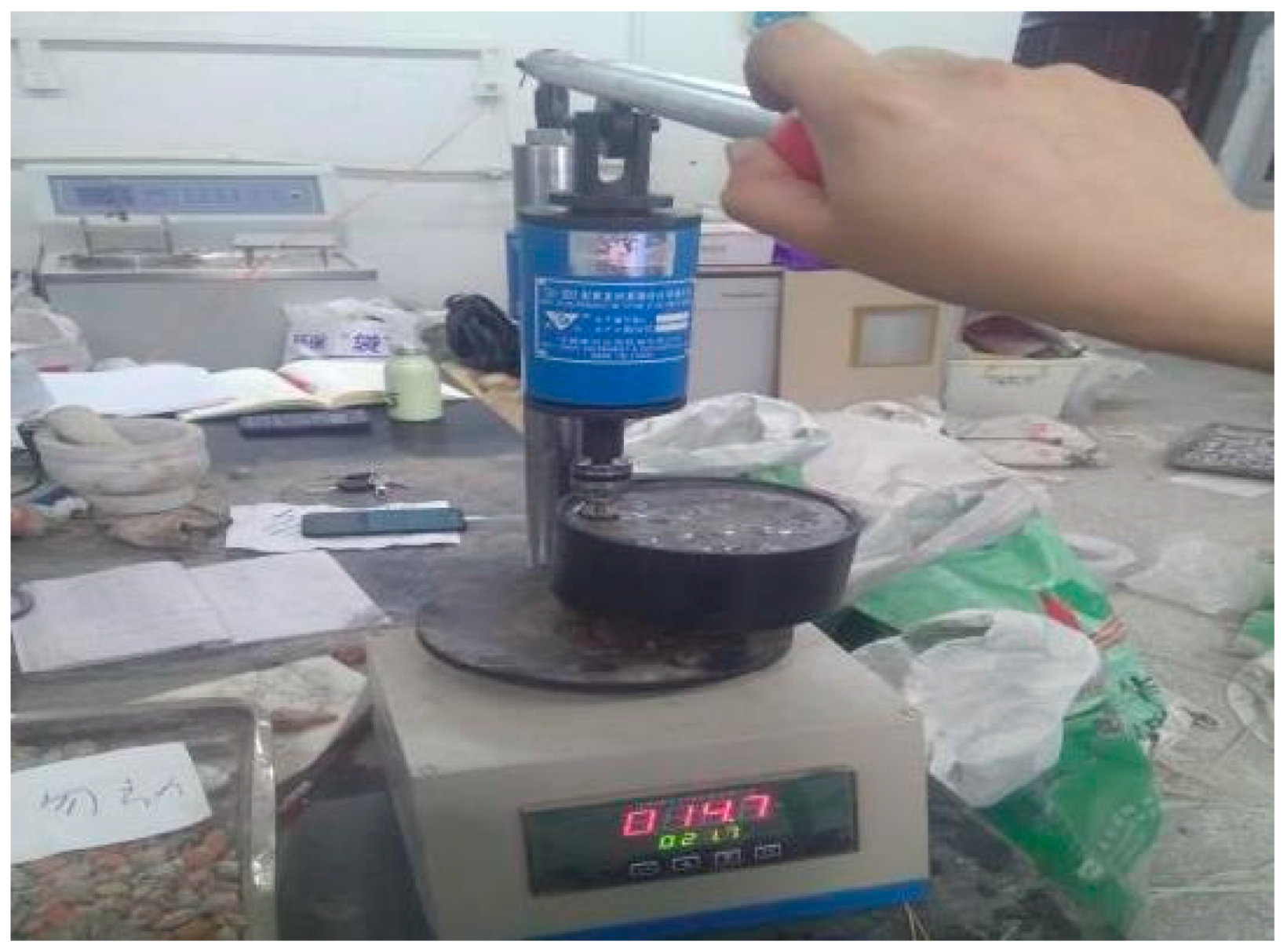
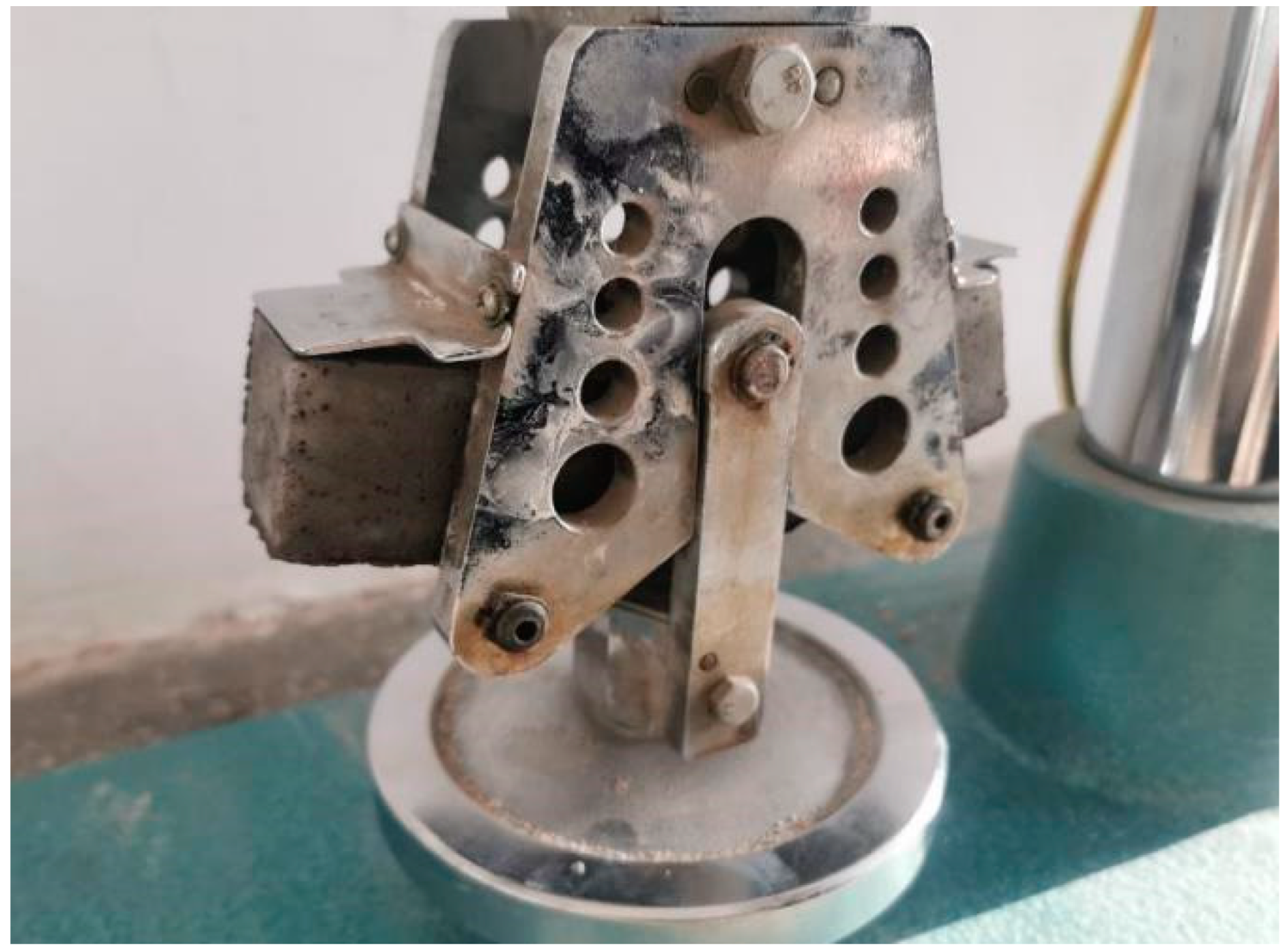
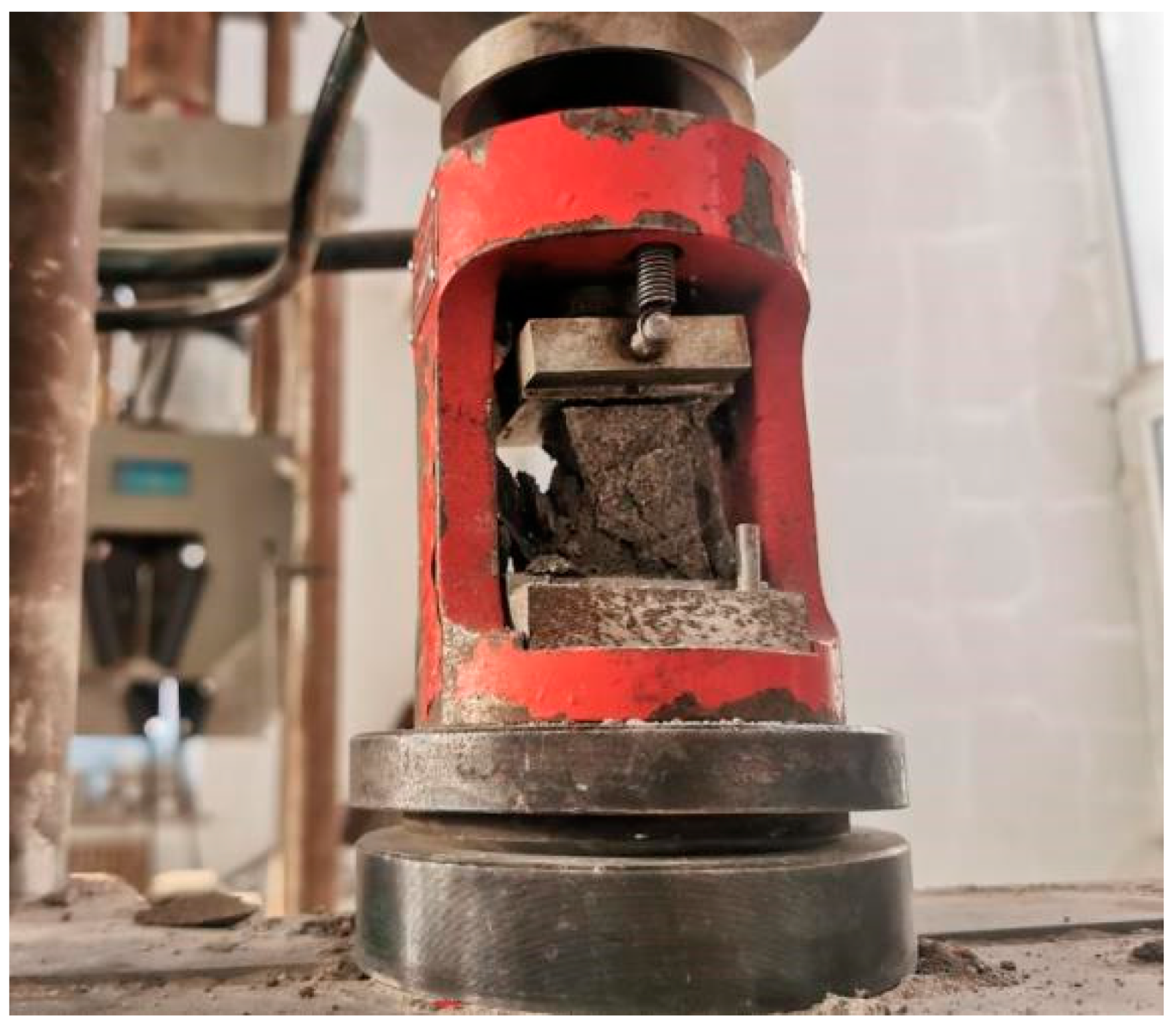
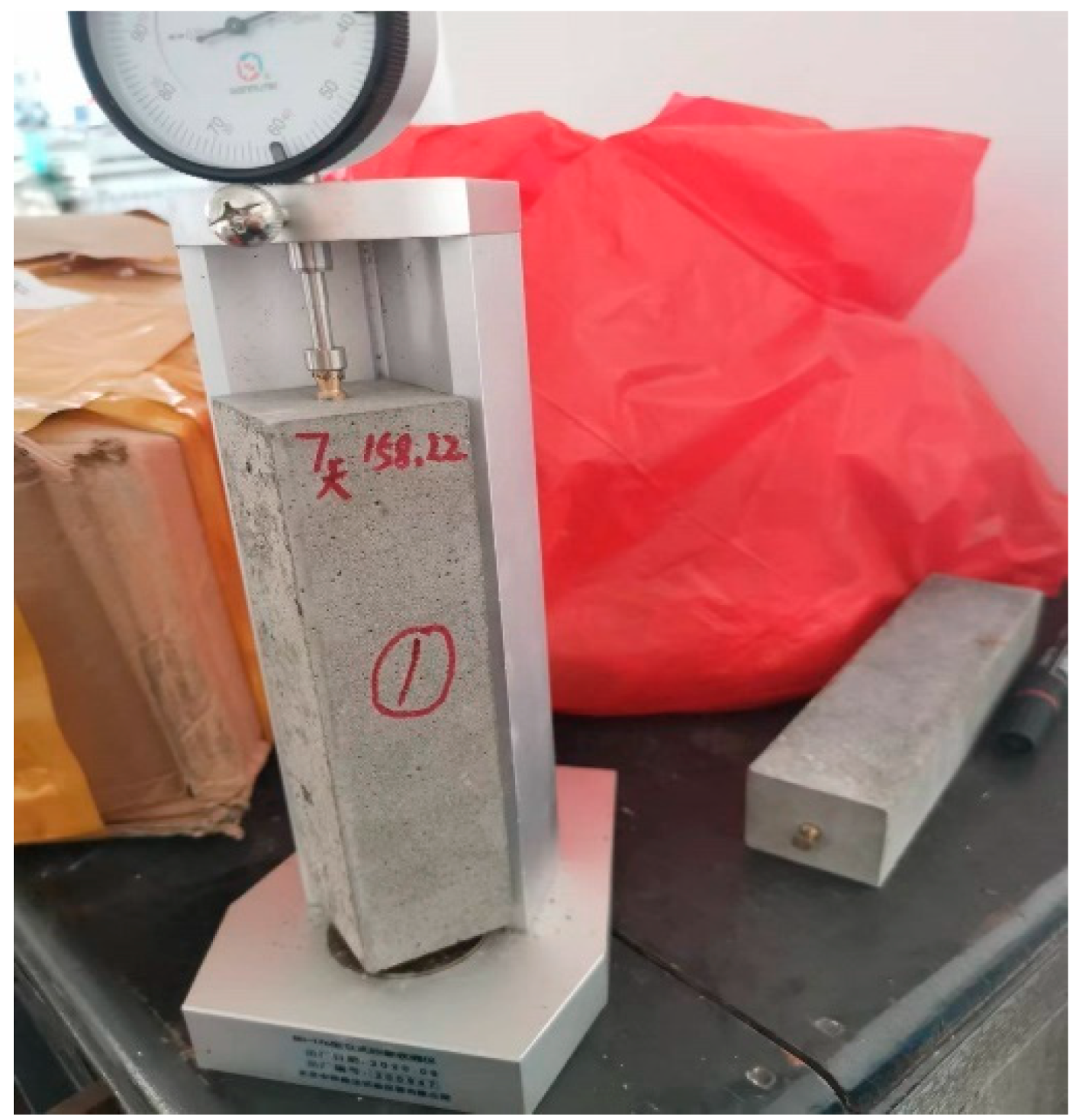
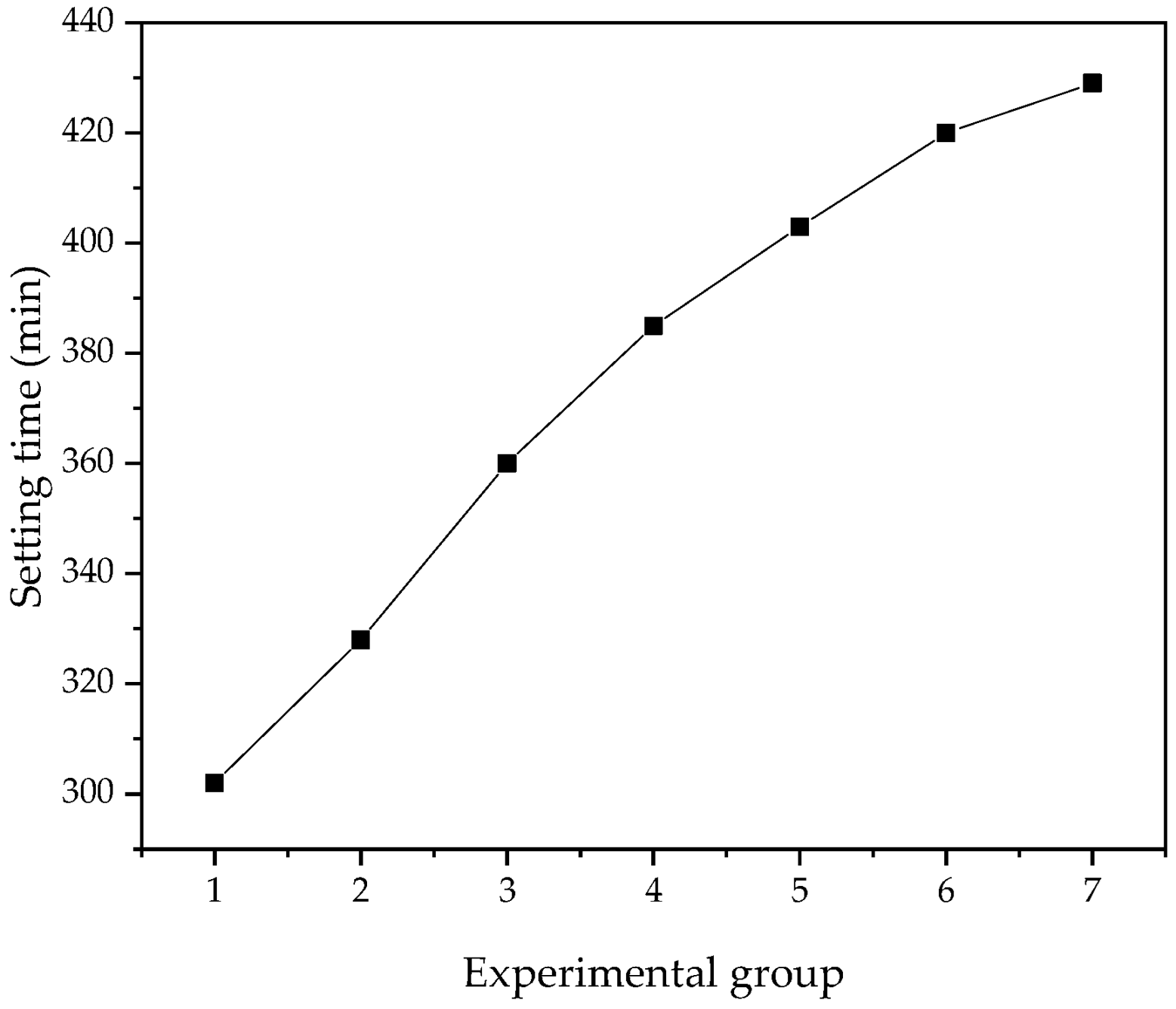
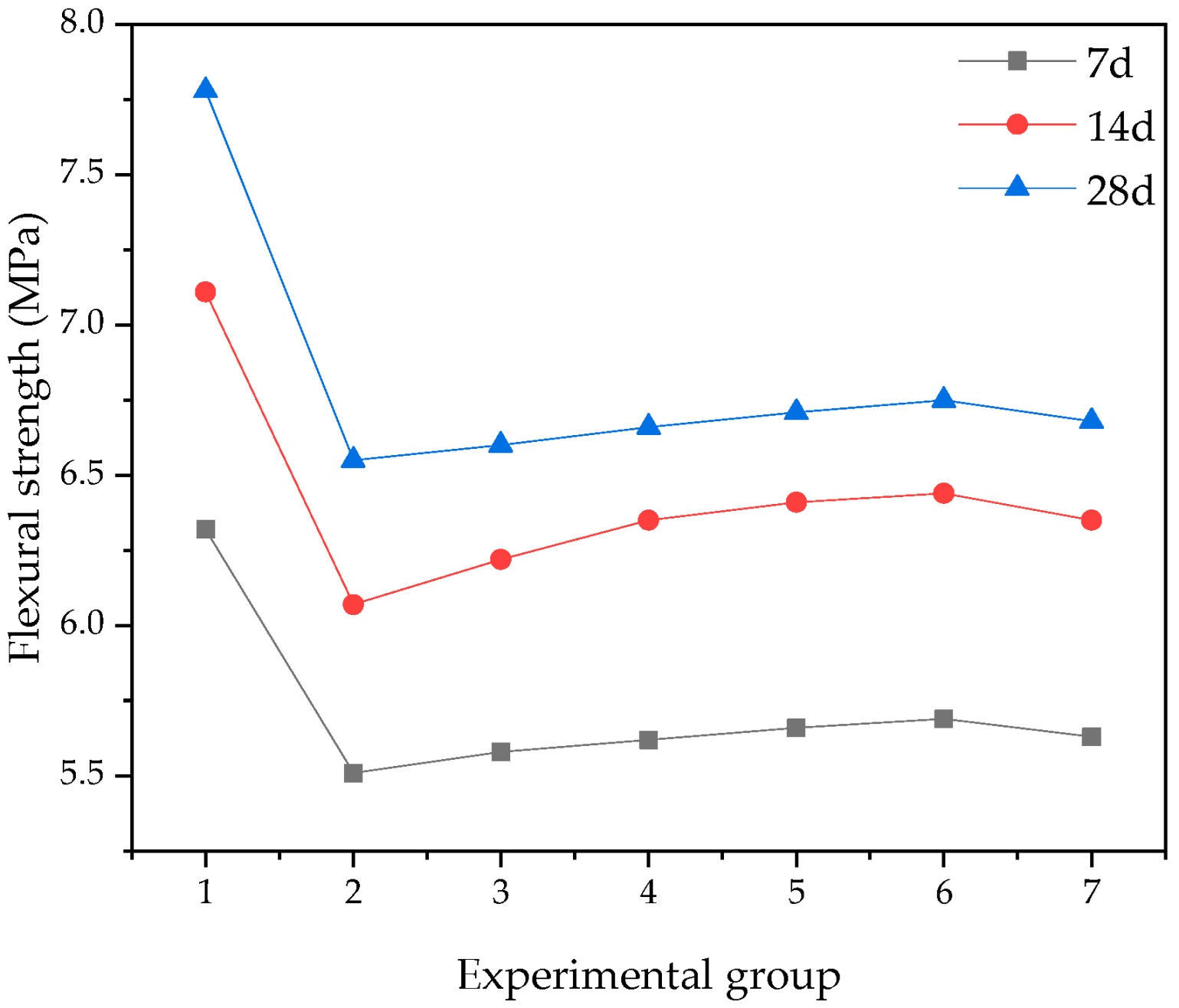
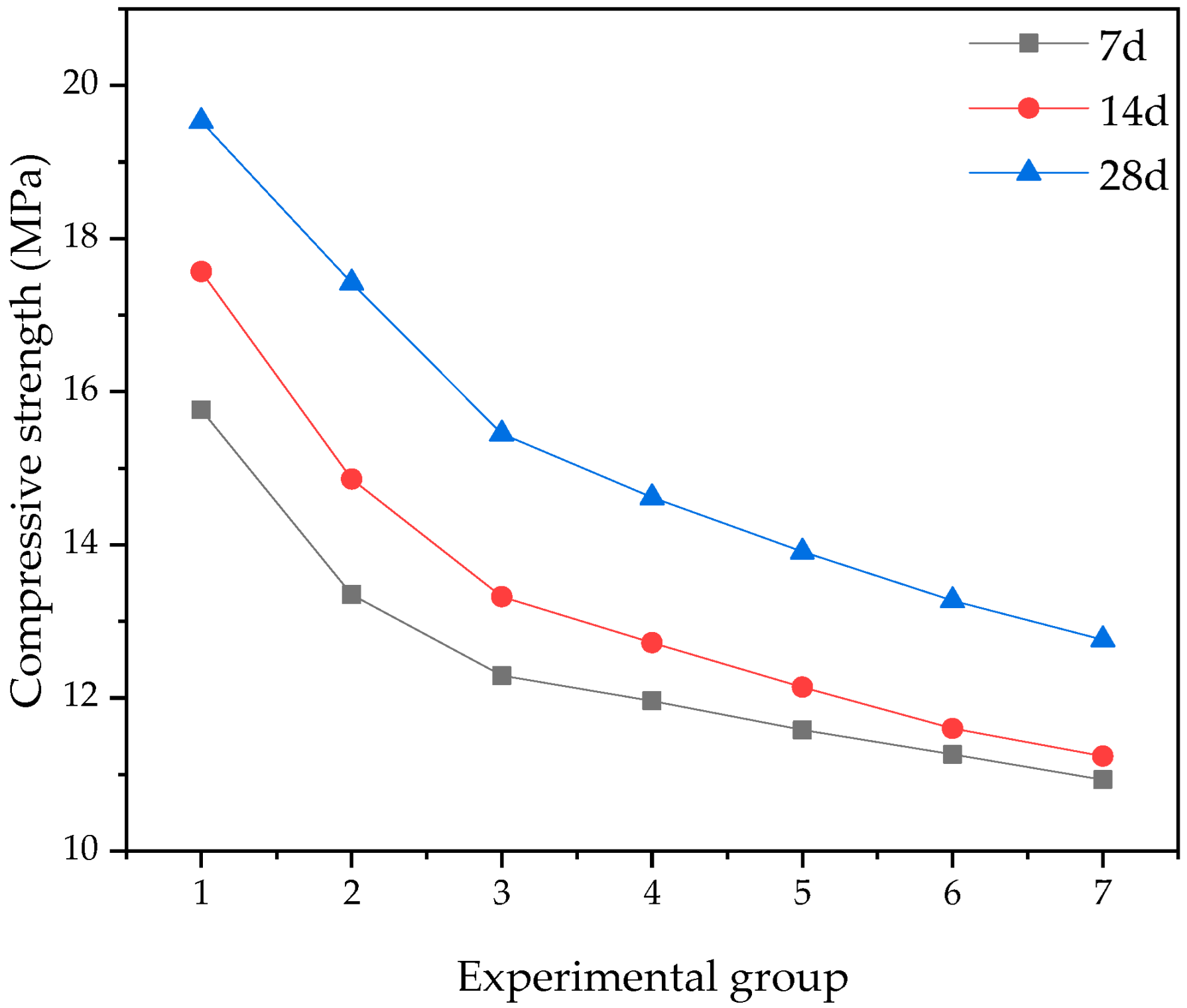

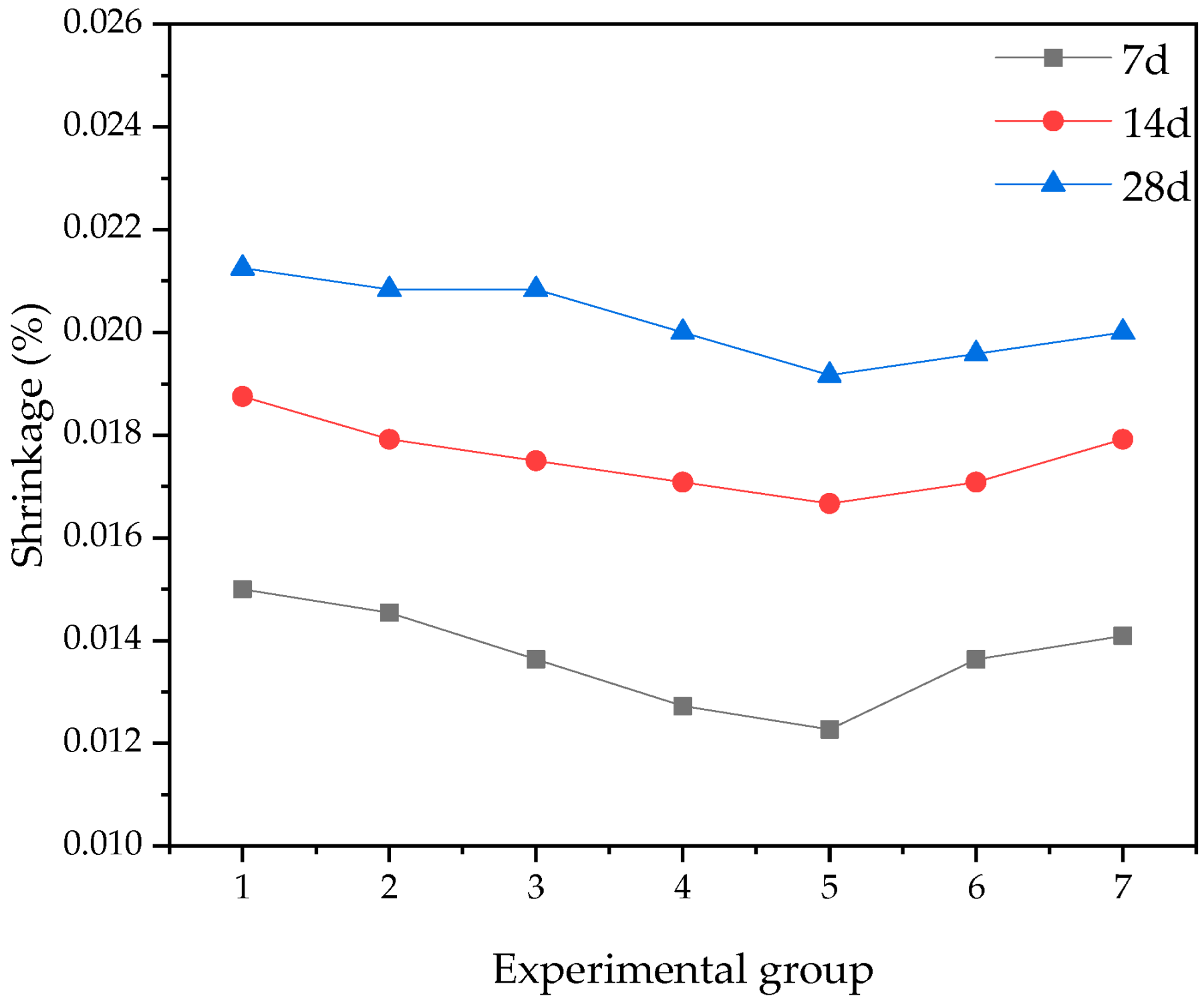
| Specific Surface Area (m2/kg) | Setting Time (min) | Density (g/cm3) | Flexural Strength (MPa) | Compressive Strength (MPa) | Stability | |||
|---|---|---|---|---|---|---|---|---|
| Initial Setting | Final Setting | 3d | 28d | 3d | 28d | |||
| 361 | 180 | 260 | 2.83 | 5.42 | 9.24 | 25.76 | 50.02 | Qualified |
| Apparent Density (kg/cm3) | Moisture Content (%) | Fineness Modulus | Void Fraction (%) | Particle Size (mm) | Packing Density (kg/cm3) |
|---|---|---|---|---|---|
| 2570 | 2.8 | 2.0~2.5 | 36.2 | <4.75 | 1426 |
| Density (g/cm3) | Specific Surface Area (m2/kg) | Moisture Content (%) | SiO2 | Al2O3 | Fe2O3 | Na2O | MgO | CaO |
|---|---|---|---|---|---|---|---|---|
| 2.22 | 419 | 0.3 | 56.20% | 26.40% | 4.30% | 3.20% | 2.80% | 1.50% |
| Packing Density (g/L) | PH | Density (g/cm3) | Specific Surface Area (m2/kg) |
|---|---|---|---|
| 465 | 8 | 1.045 | 346.7 |
| Group | Cement (g) | Sand (g) | Water (g) | Water Reducing Agent | Fly Ash (g) | Redispersible Latex Powder |
|---|---|---|---|---|---|---|
| 1 | 500 | 1300 | 260 | 0.10% | 0 | 0% |
| 2 | 400 | 1300 | 260 | 0.10% | 100 | 0% |
| 3 | 400 | 1300 | 260 | 0.10% | 100 | 1% |
| 4 | 400 | 1300 | 260 | 0.10% | 100 | 2% |
| 5 | 400 | 1300 | 260 | 0.10% | 100 | 3% |
| 6 | 400 | 1300 | 260 | 0.10% | 100 | 4% |
| 7 | 400 | 1300 | 260 | 0.10% | 100 | 5% |
Publisher’s Note: MDPI stays neutral with regard to jurisdictional claims in published maps and institutional affiliations. |
© 2022 by the authors. Licensee MDPI, Basel, Switzerland. This article is an open access article distributed under the terms and conditions of the Creative Commons Attribution (CC BY) license (https://creativecommons.org/licenses/by/4.0/).
Share and Cite
Liu, C.; Jia, Y. Effect of Redispersible Latex Powder and Fly Ash on Properties of Mortar. Coatings 2022, 12, 1930. https://doi.org/10.3390/coatings12121930
Liu C, Jia Y. Effect of Redispersible Latex Powder and Fly Ash on Properties of Mortar. Coatings. 2022; 12(12):1930. https://doi.org/10.3390/coatings12121930
Chicago/Turabian StyleLiu, Chi, and Yanmin Jia. 2022. "Effect of Redispersible Latex Powder and Fly Ash on Properties of Mortar" Coatings 12, no. 12: 1930. https://doi.org/10.3390/coatings12121930
APA StyleLiu, C., & Jia, Y. (2022). Effect of Redispersible Latex Powder and Fly Ash on Properties of Mortar. Coatings, 12(12), 1930. https://doi.org/10.3390/coatings12121930





